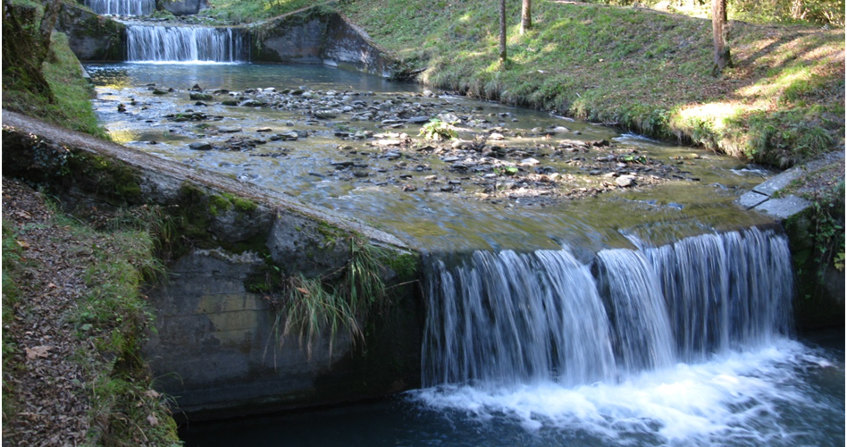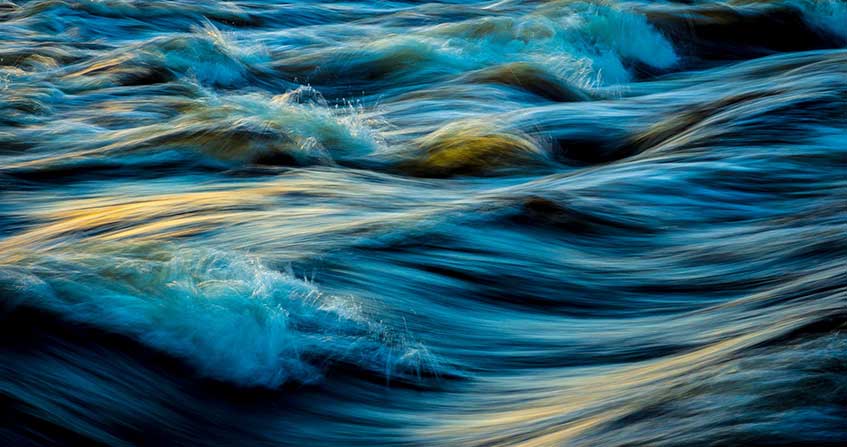如何协调解决水坝和泥沙沉积问题?
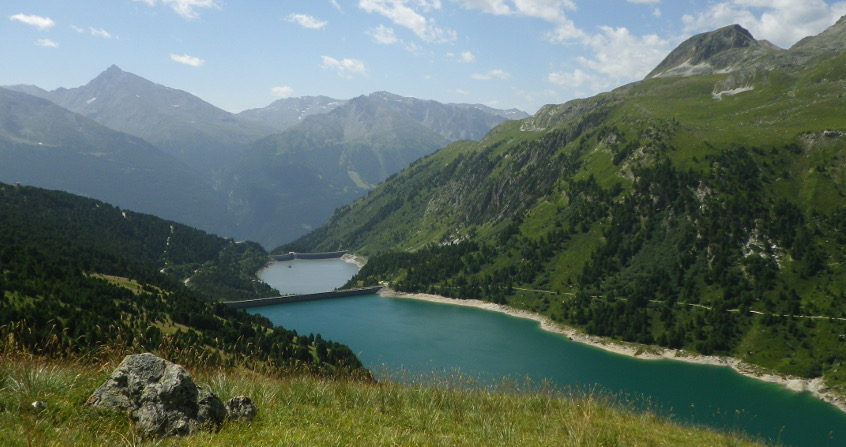
水坝作为一项现代科技壮举,具有洪涝控制、河流水位调控、农业灌溉和娱乐项目开发等多项功能,其中水力发电也已发展为可再生能源利用的第一梯队。然而,由于沉积泥沙等颗粒物,水坝也会显著改变河道状况、下游土壤的肥力和相关的生态系统,并最终改变海岸形状。那么,为了限制以上影响,设计水坝时面临的主要挑战有哪些?
1. 水坝的位置和用途
1.1. 全球范围内的水坝规模
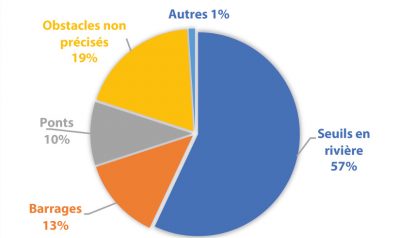
截至2018年,全球约有80万座水坝[1] [2],其中有58,519座水坝达到大型水坝标准[3]。目前全球48%的河流处于被调控和/或被分割的状态[4]。水坝在过去20年的建设速度相对缓慢,但近年来却以前所未有的建设数量快速增长,如果以目前的建设速度,预计到2030年,93%的河流将会被调控和/或分割。
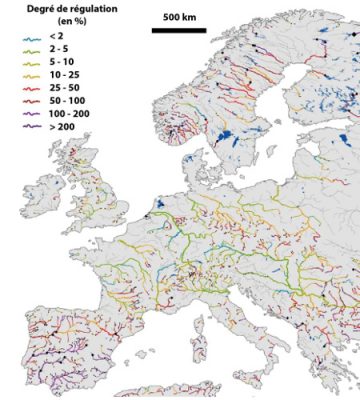
法国共有569座大型水坝[5],占法国国家河道人工构筑物的 13%,(作为对比,潜水坝的占比为57%)[6](图1)。另外大坝对于河道[8]调控程度会受到大坝位置的影响[7](图2)。调控程度越高,河道的自然功能被影响的就越多(如水的停留时间)。水坝在法国分布非常不均衡,在卢瓦尔盆地上游的多尔多涅河、罗纳河和阿尔卑斯山脉的分布最多。
1.2. 水坝的作用
水坝建设可分为以下几种类型:
- 柔性结构,如回填土坝(与重力坝具有相同特性);
- 刚性结构,如重力坝(压在地面上,水坝重量单独可以承受水库中水所施加的推力。图3);拱型坝(拱形,水的推力被传递到山谷两侧和河岸);支墩坝(大型混凝土墙位于支墩上并将水压推向地面)。
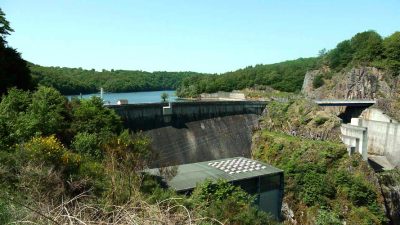
基岩性质、地形、集水区固体输入、河流水文状况和开发河谷形貌是决定坝体类型的主要因素。它们的特殊性将决定水坝的使用和管理。1675年在米迪运河建造的圣费雷奥大坝,高30 米,是法国第一座大型水坝[9]。建造该类型的水坝主要为满足以下需求:
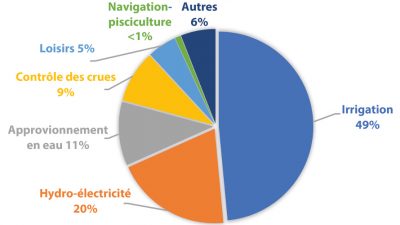
- 为工业活动(特别是采矿和冶金活动)供水。工业生产耗水量很大,特别是在19世纪中叶;
- 饮用水供水水源;
- 灌溉;
- 用于水力发电(主要从20世纪开始);
- 增加枯水期流量并控制洪水;例如塞纳河在20世纪初发生大洪水之后,就建造了被称为 “塞纳河大湖”的水库大坝;
- 内陆航行。
从使用功能来看,将近一半的水坝功能单一,其余的或多或少都有多种用途。因此现在的一些水坝往往具有娱乐功能(娱乐基地)(图4)。
2. 水坝如何影响沉积物的连续性
产生及改变沉积物的过程包括侵蚀、搬运、沉积和挤压等活动。在河流上建造水坝将导致水文形态和理化性质的改变,特别是会对颗粒物沉积和水生态的连续性造成破坏。水坝构筑物会显著改变河流的水文状况,使之从河流型水动力状态(具有与水流相关的湍流)转变为接近湖泊型的相对静态水动力状态(较平静,湍流较少)。这种流场的改变使得细小颗粒极易在大坝附近聚集,而较粗的颗粒更多地堆积在大坝尾部(图5)。
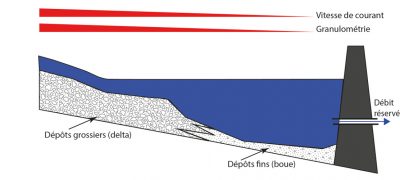
水坝可以在河道的很长一段距离内对从上游到下游的泥沙等沉积物流动造成扰动,有时甚至可以延伸到河口处。水坝作为一道物理屏障可以有效固定沉积物。据估计从流域集水区带来的沉积物中有70% ~ 90%被截留[10] [11],并且沉积物按照粒度大小被筛分。例如,粗大的卵石或沙子会在水库中堆积,这将影响下游贫水区和河滨生态系统的生物栖息环境,随着时间推移还会促使河床下沉(或出现切口)。
另一方面,水库内沉积细小颗粒物导致下游细颗粒物减少也会产生负面影响,例如会减少向下游的营养物质传输量。另外水坝建设会降低河水的浑浊度,这不利于某些鱼类躲避捕食者。水坝的建设还会阻止洪水将肥沃的淤泥带入下游的农田土壤[12](如埃及尼罗河上的阿斯旺大坝)。
沉积物被截留的比例取决于水流在大坝中的滞留时间。因此,大坝水库内的沉积物来自于其所在流域集水区域的侵蚀产物。取决于岩石性质(岩石的地质性质),这些沉积性物质会或多或少地沉积储存在大坝水库中。很明显,碳酸盐岩石集水区和花岗岩等结晶型岩石集水区带来的并在水库中沉积的颗粒物质,其性质或数量会有所不同。类似地,流域的开发会显著影响沉积物的性质和丰度。实际上,对地质构造的侵蚀而产生的颗粒物质贡献取决于森林、农业、工业活动和城市化的主导地位。
水坝的高度、位置(一般在集水区上游)、同一河道中梯级水坝的数量对于河道的影响程度有所不同。按绝对值计算,由于河流水文功能的变化,水坝会导致集水区上游区域的侵蚀加重,从而增加沉积物负荷[13]。但由于大部分沉积物会储存在水库中,正如我们所观察到的,下游的沉积物会减少。
然而,固体物质的沉积对于水坝下游河道在维持其形貌和生态特性方面是绝对必要的。总的来说,由于沉积物质的减少,水坝建设必然会使得河岸、三角洲、河口和海岸形貌发生改变,最终导致更大规模的海岸侵蚀。
3. 如何处理沉积物随时间不断累积的问题?
对蓄水大坝的管理不仅涉及其结构,对沉积物质的管理也是十分重要的。沉积物会在水库中储存或者在水库中借助水流进行迁移。在设计过程中,大坝的使用寿命是根据流域内沉积物的沉积速率和体积来估算的。然而,在实际使用寿命周期内,构筑物的尺寸往往被低估。因此,沉积物质堆积必然带来长期影响:
- 通过影响水电大坝的储水量来降低水电大坝的运行效率;
- 影响水资源管理;
- 削弱或加速大坝结构的老化,从而影响其安全性;例如,在阿尔卑斯山罗曼奇河上建造的尚邦水坝,颗粒物的沉积使其构造出现断裂的风险,因此从2013年起对大坝展进行加固;
- 影响其调控洪水的作用(上限);
- 永久减少下游河道中沉积物的数量和粒度。
在水库中累积的固体物质的量可以达到数千立方米,且与相同大小的天然湖泊相比,沉积速率通常要高得多。
出于成本或环境影响方面的考虑,对沉积物的管理通常采用定期以及或多或少次数的全排空方式进行。可以通过不同的方法来实现对沉积物的管理:
- 减少大坝上游沉积物的输入量;
- 清洗去除已经积累的沉积物;
- 使沉积物在特定时间通过大坝或绕过大坝(请阅读焦点)。
为了解决这些与大坝建设相关的问题,目前有一些方案正在实施或给予了充分考虑,其中大坝位置的选择至关重要。水坝需在集水区上游建造,另外还需考虑到所选地点的侵蚀倾向、所涉及的固体物质负荷、待开发河流的水文形态特征等。同时也可考虑其他解决方案,如安装旁路系统,或安装或多或少容许细小沉积物通过的涡轮发电机。
因此,由于时间推移所导致的沉积物在水库中的淤积问题需要特殊的管理方式方法,且沉积物不同其管理难度也不尽相同。实际上,由于大坝所导致的超级污染积累,大量高度污染的沉积物不能通过水坝直接排入到河道下游的自然环境中,此举措会导致河道下游严重的污染问题。
4. 受污染沉积物大量排放的风险
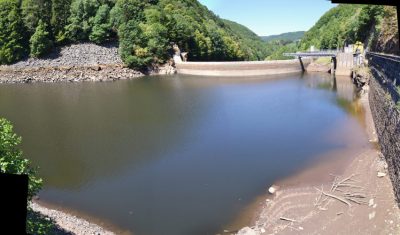
水坝还将改变主要元素(Si,Fe等)、微量元素和/或污染物(As,Cd等)以及颗粒态营养物质(有机物、磷、氮等)的地球化学循环。实际上这些元素要么被固定在沉积物中,要么与沉积物有关联。由于大坝可以造成水体和沉积物的物理和化学性质变化,因此可以促使这些沉积物的再度释放(图6)。此外,沉积物的特性是管理累积下来的沉积物时需要考虑的一个主要因素。沉积物的特性将决定考虑施行的沉积物管理甚至恢复沉积物连续性的方法,这些方法不会对大坝下游的水生生物造成风险(见第三节)。
自然条件下,大坝所在流域集水区的地球化学物质含量可能会高于全国平均水平(例如存在矿脉)。无论是自然原因还是其他因素,这种对沉积物特性的干扰主要与无机污染物有关。这些元素通常是金属或类金属,并且通常以低浓度(或痕量浓度)存在。它们可能对环境具有潜在毒害,这主要取决于其存在形式(物种类别和矿物学形态)。通常包括以下元素:砷、镉、铬、铜、汞、镍、铅、锑和锌。
如果这些元素浓度过高,通常与流域集水区内的人类活动有关。采矿活动开采这些元素将影响附近水道中沉积物的特性[14](如卢瓦尔河流域上游地区的维勒斯特水坝所示)。实际上自然资源的开采将使一些原本在岩石中稳定存在的元素变得可获取和易迁移。与岩石的开采和破碎(减小粒径)有关的活动将改变环境的理化性质,并促进矿物相的氧化和水解过程。这些元素随后在沉积物中重新分布并流入到大坝水库中,因此沉积物中所含元素的流动性和反应活性要比初始状态高。
同时沉积物中也可能存在有机污染物:如持久性有机污染物(POPs)。它们可能源于自然过程(森林火灾、火山爆发等)或人为活动。某些工业过程或农业活动产生的排放物——多环芳烃(PAHs)、多氯联苯(PCBs)、农药(有机氯)等对沉积物也有显著影响。例如,意大利中部阿尔卑斯山的20个水库存在多氯联苯污染[15]。生活污水尾水排放以及农业活动也导致了磷(P)的释放,这会引起大坝水库的富营养化。在夏季富营养化会导致蓝藻大量繁殖,产生毒素(蓝藻毒素)。这种水库将不再适合进行游泳等娱乐活动(请阅读磷与富营养化)。
对大坝水库中的受污染沉积物进行管理需要非常精细的操作,有时甚至不可能实现。这导致不得不终止大坝的功能,甚至需要对大坝进行拆除,使河道回归至其最初状态(也称为清除)。然而,对大型水坝而言,拆除水坝以恢复水道的沉积和生态连续性似乎很难实现。但是,这种情况并不妨碍我们在某个时候不得不对多年来积累下来的沉积物进行处理和管理,无论这些沉积物是否被污染。
5. 需记住的信息
- 预计到2030年会恢复大型水坝的建设,不可否认它们会在发电和储能、洪涝和干旱调节、农业灌溉等方面发挥至关重要的作用。
- 但是,水坝形成了一道物理屏障,特别是改变了有关水道的水文状况、理化性质和固体物质负荷。
- 偶尔也存在可以恢复沉积物迁移的解决方案,但是对人造水库的沉积物进行管理很困难,因为在沉积过程中,由于停留时间很长,这些沉积物会富集大量有机和无机污染物。
参考资料及说明
封面图片:上莫里安河谷上游及下游大坝计划 [来源:© Photo A. Courtin-Nomade.]
[1] McCully, P., (2001). Silenced rivers: the ecology and politics of large dams. Zed Books Publisher
[2] Friedl, G. & Wüest, A. (2002). Disrupting biogeochemical cycles – Consequences of damming. Aquatic Sciences, 64, 55-65.
[3] 坝高超过15米以上,在基础水平之上或着在5米和15米之间,容量大于3亿立方米。http://www.icold-cigb.net/home.asp, January 2018
[4] Grill, G., Lehner, B., Lumsdon, A.E., MacDonald, G.K., Zarfl, C., Lierman,n, C.R. (2015). An index-based framework for assessing patterns and trends in river fragmentation and flow regulation by global dams at multiple scales. Environmental Research Letters, 10, 1-15.
[5] Zarfl, C., Lumsdon, A.E., Berlekamp, J., Tydecks, L., Tockner, K., (2015). A global boom in hydropower dam construction. Aquatic Sciences, 77, 161-170
[6] 固定或移动构筑物部分或完全阻塞河流河床,对比下,大坝会阻塞更多河床的大坝。
[7] 河道状况(如流量)的变化可能会受监管力度的影响,特别是水停留时间。大力度的监管意味着在特定年份大量临时储存的水排放的可能性很大。水体临时储存和释放将改变河流的自然状况,且由于水库内水体的停滞和分层,会影响如温度、溶解氧浓度或固体物质负荷(悬浮固体)等参数。因此具有多年蓄水能力且其运行完全由需水量(例如,低水位上升、洪水调节)控制的水库的调节度高于100%。
[8] Lehner, B., Liermann, C. R., Revenga, C., Vörösmarty, C., Fekete, B., Crouzet, P., Döll, P., Endejan, M., Frenken, K., Magome, J., Nilsson, C., Robertson, J. C., Rödel, R., Sindorf, N., Wisser, D., (2011). High-resolution mapping of the world’s reservoirs and dams for sustainable river-flow management. Frontiers in Ecology and Environment, 9, 494-502.
[9] Bordes, J.L., (2006). Les barrages du XVIIe siècle à la fin du XIXe, transferts technologiques et modes d’élaboration des ouvrages, in Les Archives de l’invention, colloque des 26-27 mai 2003, Conservatoire national des Arts et Métiers, Toulouse, CNRS/Université de Toulouse-Le Mirail, 227-240
[10] Vörösmarty, C.J., M., M., Fekete, B., Sharma, K., Green, P. & Syvitski, J.P. (2003) Anthropogenic sediment retention: major global impact from registered river impoundments. Global and Planetary Change, 39, 169-190
[11] Toniolo, H., Schultz, J. (2005). Experiments on sediment trap efficiency in reservoirs. Lakes & Reservoirs: Research and Management, 10, 13-24
[12] Pacini, N., Donabaum, K., De Villeneuve, P.H., Konecny, C., Pineschi, G., Pochon, Y., Salerno, F., Schwaiger, K., Tartari, G., Wolfram, G., Zieritz, I. (2013). Water quality management in a vulnerable large river: the Nile in Egypt. International Journal of River Basin Management, 11, 205-219.
[13] Van Maren, D.S., Yang, S.-L., He, Q. (2013). The impact of silt trapping in large reservoirs on downstream morphology: the Yangtze River. Ocean dynamics, 63, 691-707.
[14] Dhivert, E., Grosbois, C., Coynel, A., Lefèvre, I., Desmet, M. (2015). Influences of major flood sediment inputs on sedimentary and geochemical signals archived in a reservoir core (Upper Loire Basin, France). Catena, 126, 75-85
[15] Laura, M., Tartari, G., Salerno, F., Valsecchi, L., Bravi, C., Lorenzi, E., Genoni, P., Guzzella, L. (2017). Climate Change Impacts on Sediment Quality of Subalpine Reservoirs: Implications on Management. Water, 9, 680.
环境百科全书由环境和能源百科全书协会出版 (www.a3e.fr),该协会与格勒诺布尔阿尔卑斯大学和格勒诺布尔INP有合同关系,并由法国科学院赞助。
引用这篇文章: COURTIN-NOMADE Alexandra (2024年3月9日), 如何协调解决水坝和泥沙沉积问题?, 环境百科全书,咨询于 2025年4月3日 [在线ISSN 2555-0950]网址: https://www.encyclopedie-environnement.org/zh/eau-zh/how-reconcile-dams-sediment-transport/.
环境百科全书中的文章是根据知识共享BY-NC-SA许可条款提供的,该许可授权复制的条件是:引用来源,不作商业使用,共享相同的初始条件,并且在每次重复使用或分发时复制知识共享BY-NC-SA许可声明。







